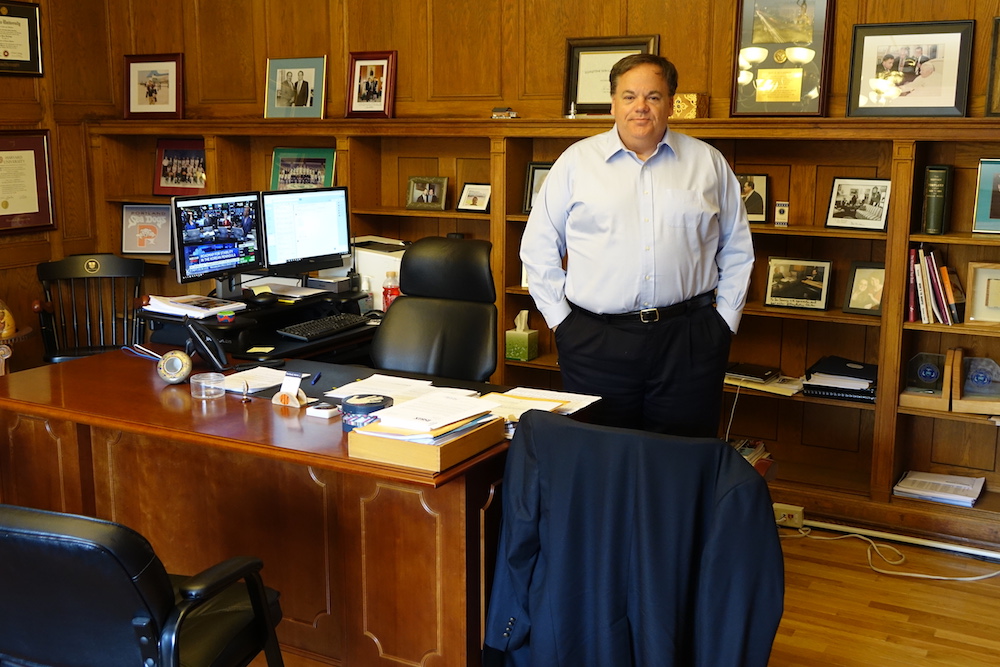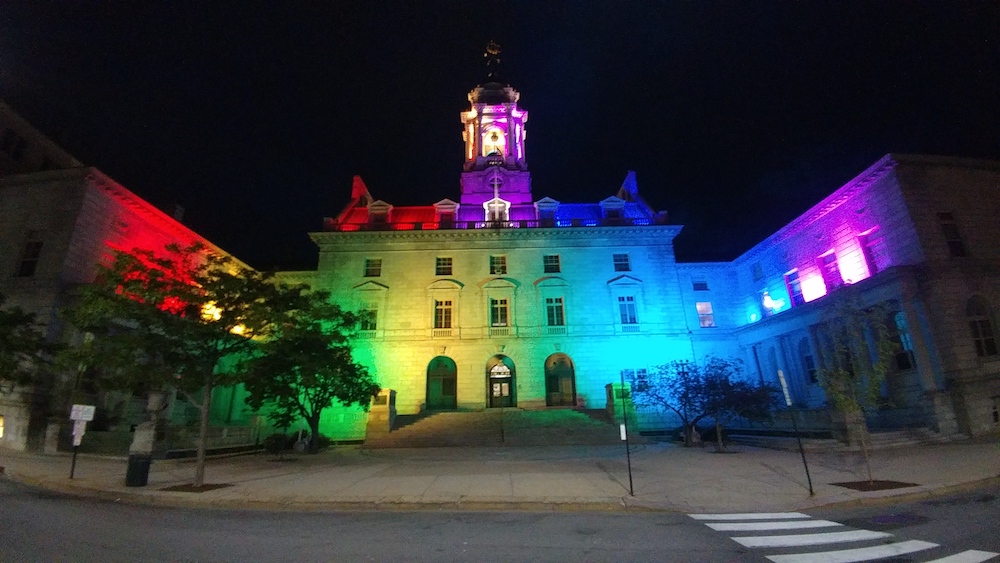Connecting state and local government leaders
The city hopes a new tech upgrade will cut wait times at one difficult commuter bottleneck by 20 to 30 percent.
PORTLAND, Maine — City officials here will flip the switch next week on an innovative system designed to ease traffic flows through the most congested intersection in the Pine Tree State.
They expect the Morrill’s Corner project to cut wait times along the important commuter roads feeding through the intersection by 20 to 30 percent. Bottlenecks there have frustrated drivers for years. It’s a problem every weekday, since the city’s core population of 67,000 swells to 200,000 as suburban workers drive to their jobs.
The project is only one of several traffic-related initiatives the city has ambitions to complete in the next few years, as it attempts to keep the high quality of life that has been a magnet for companies and workers in recent times. To knuckle under to a life of gridlock would be to jeopardize the “secret sauce” that makes Portland such a desirable location, said City Manager Jon Jennings in a recent interview.
A true technophile, Jennings believes that a wide variety of “smart” systems will improve life in the city. Portland will soon finish replacing all of its street lights with a state-of-the-art LED system that is electronically linked and compliant with dark-sky standards. It has just gone live with public wi-fi systems in two much-used parks. And the city will soon launch a project to address conflicts between pedestrians and vehicles along the busy waterfront. Portland is an ideal testbed for cutting-edge solutions to problems found in many larger cities, Jennings said.
The Traffic Challenge
Portland’s traffic congestion was on display on a recent morning during a drive from Falmouth on Interstate 295. One key southbound exit turned out to be in gridlock, held up by poorly coordinated lights within one block of each other, one controlling us and the other controlling northbound drivers who were also exiting 295 and competing to get onto Franklin Street to go downtown.
At City Hall, Jennings and his technology adviser Troy Moon said the Franklin Street bottleneck is on the agenda after the Morrill’s Corner and associated traffic problems are addressed.
Moon took this Route Fifty correspondent out to Morrill’s Corner. As if to underline the point that traffic is a big problem in Portland, we got stuck at Woodford Corner, just a mile or so from our destination. What seemed like an easy right turn was prohibited by traffic signals feeding other roads through the intersection, with the delay exacerbated by a passing train that blocked one of the thoroughfares.

Finally breaking free, we drove through Morrill’s Corner from every direction, along the major commuter routes that feed the city’s workers to their jobs.
Moon explained that the new system uses radar sensors measuring oncoming traffic along five different roads that feed into the bottleneck. They are in turn connected to new smart signals that adjust their timing to accommodate the highest possible traffic flow. The relatively small number of pedestrians crossing Morrill’s Corner intersections can punch a button to allow them to cross.
The system was developed at Pittsburgh’s Carnegie Mellon University. Researchers there recently spun it out as a new company, Rapid Flow Technologies LLC, with the goal of commercializing the Surtrac adaptive signal control technology developed in the university’s Robotics Institute.
The company’s website describes Surtrac as “an innovative approach to real-time traffic signal control, combining research from artificial intelligence and traffic theory. Surtrac optimizes the performance of signals for the traffic that is actually on the road, improving flow for both urban grids and corridors and leading to less waiting, reduced congestion, shorter trips, less pollution, and happier drivers.”
The technology has been piloted in Pittsburgh over the past three years and now extends to a network of 47 intersections. Atlanta is also experimenting with Surtrac.
Municipal technologist Moon, whose title is actually sustainability coordinator, drove Route FIfty by another of the city’s initiatives to reduce its carbon footprint, a solar installation on the roof of the city-owned Riverside Golf Club’s electric cart storage barn. The carts, he noted proudly, are now off the grid, at a cost, or investment, that will be defrayed over the next few years.

Optimizing Flows
Assuming that the system proves itself at Morrill’s Corner, Portland expects to extend it along major commuter arteries leading from that busy intersection into downtown, said Jennings.
Drivers shouldn’t expect miracles overnight. A city press release in early June said people passing through the corner “will notice a 20 to 30 percent reduction in travelling times.” But accurate measurements may take a while to develop, according to the contractor who developed the system.
In an interview with Route Fifty, Greg Barlow, the chief technology officer and founder of Rapid Flow Technologies, the Carnegie Mellon spin-out, explained Surtrac’s development over the past eight years and its deployment in Pittsburgh and Atlanta, the first cities to try it.
Barlow noted that cities have long managed traffic flows along major routes by staggering lights to promote smooth passage and minimize delays. But these systems do not address complex urban intersections, and it’s here that Rapid Flow hopes to make a difference.
Carnegie Mellon began working on adaptive signal control technology in 2010, said Barlow, funded by generous grants from philanthropist Henry Hillman. Over the past decade, the university’s transportation research has also found other sources of support, including federal money.
By 2012, researchers were ready to deploy their adaptive signal technology. They worked with city officials to chose nine intersections in Pittsburgh.
It was “very different from stagger-signal systems used along suburban corridors,” said Barlow. The new technology was “designed for urban networks with complex, dynamic traffic flows,” he added, and it featured automated “communication between intersections.”
Pittsburgh afforded an ideal testing ground, and the system gradually expanded over the years to encompass nearly 50 intersections. Measuring results with the adaptive technology is tricky, Barlow said, but his company has made an exhaustive study of the system’s performance in Pittsburgh. He said it showed a 40 percent reduction in wait times during the day, a reduction of 30 to 40 percent in numbers of stops, a 20 percent reduction in tailpipe emissions, and a reduction of 25 percent in travel times. The configuration of the city’s streets and intersections were perfectly suited to the system’s capabilities, he added, and also well suited for detailed assessments of results.
Last year, Atlanta signed on in the hope that Surtrac would ease congestion in intersections along roads between Georgia Tech and the downtown business district. The deployment was done quickly: Atlanta first expressed interest in April; the build-out began in September and was was completed by year’s end.
Details of the North Avenue smart corridor, as it’s called, were described in Metrolab’s Innovation of the Month series in October. One of the experts interviewed by Metrolab was Faye DiMassimo, a long-time transportation planner who is executive director of Renew Atlanta, which helps oversee allocation of revenues from a special purpose local option sales tax for transportation the city’s voters approved in 2016. DiMassimo said:
The design includes the installation and use of over 100 IoT sensors at 18 signalized intersections, an adaptive signal timing system, vehicle-to-infrastructure communications, and reconfiguration of the existing roadway through restriping to support crash reduction and future acceptance of autonomous vehicles.The adaptive signal technology combines artificial intelligence with traffic theory. The system is designed for an urban setting, which takes into consideration non-vehicular modes, including pedestrians, bicyclists and transit. It responds in real time to these mobility types through advanced video detection systems that identify vehicle types, speed, volumes and queues. Thermal imaging and video cameras provide pedestrian and bicycle detection for adaptive control of the traffic signals, relieving these roadway users from having to push a button.
Barlow said he did not yet have a full evaluation of how his technology is working in Atlanta, but that signs so far are positive.
In Portland, Rapid Flow Technologies is a subcontractor to TEN Connected Solutions, a subsidiary of Pittsburgh-based TEN—The Efficiency Network. Barlow couldn’t say exactly what the cost of the project here would be. But in Atlanta, he said, the cost per intersection was running at about $20,000.
What About Pedestrians?
In Portland, Barlow is expecting to work on another high-profile job: managing large volumes of both vehicular traffic and pedestrian traffic along Commercial Street, which stretches for about two miles along the city’s busy waterfront. The company is the leading candidate to take on the Commercial Street challenge, said city manager Jennings.
We drove down Commercial Street to observe the problems Jennings had described in our interview: 18 pedestrian crosswalks and only three traffic signals. Pedestrians frequently cross, causing many starts and stops along the route. A driver of an 18-wheeler told Route Fifty that he had to shift down and then up eight times for each time he had to stop along the busy street.
Commercial Street is a key hub for two of Portland’s key economic drivers—the fishing port and the tourism industry. It is where the big cruise ships tie up to disgorge their passengers. A city website describes the economy of the waterfront that stretches along Commercial Street:
“With over 350 years of history as a center for shipping, fishing, commerce, and travel, the Portland Waterfront [combines] private and public piers in support of a full range of commercial marine activities, Portland Harbor boasts a true working waterfront in the heart of Maine’s largest City. The Portland Waterfront also invites tourism with dockside restaurants, historic architecture, harbor tours, and local and international ferry service. Work and play coexist on the waterfront with a fascinating and evolving mix of uses.”
Jennings said that Portland “has been rebounding in the past three to five years. There’s tremendous interest among people who want the quality of life we offer here.” Preserving that quality, he continued, means guarding against overdevelopment, with its accompanying traffic congestion, and against making irreversible decisions “without having thought about the future.”
Planning for the future, Jennings says, will be easier once he has in hand a sophisticated electronic map of the city. It will provide an internet-based backbone allowing more traffic control measures, communications among medical and emergency vehicles, and management of a hoped-for fleet of autonomous buses and vans. Jennings says he will soon choose a vendor to execute this “big initiative.”
Even before the map is completed, work is planned on other busy commuter intersections—Woodfords Corner and ultimately all of Forest Avenue leading to downtown and along Commercial Street. Traffic flow should continue to improve as additional intersections come online because they will share information with one another.
The juncture of Franklin and Commercial streets is a bottleneck, and then the two-mile stretch of Commercial offers its own unique challenges. Jennings described an ambitious plan that would reduce the number of pedestrian walkways, install better traffic signals, and deploy camera-based technology to control pedestrian crossings by counting the number of people waiting at intersections to ensure there is critical mass before signaling a go-ahead to cross. The technology for this, Barlow said, would likely be procured from a Canada-based company called Miovision. Detroit is already using it, he said.
Jennings would like to see the number of passenger cars reduced along Commercial Street. That could be achieved, he said, by building a parking structure at the less-used end of the two-mile stretch, and procuring 12-passenger autonomous vehicles that would loop from one end of Commercial to the other.
Even more ambitiously, Jennings envisions a system of autonomous vans that could get people to downtown from the airport or the remotely located train station.
Lighting and Funding
Portland’s traffic initiatives are following in the wake of the city’s extensive program to replace all of its street lights with energy-efficient LED light fixtures. A 2013 state law allowed municipalities to purchase utility-owned street lighting equipment and Portland bought the fixtures (but not the poles) from Central Maine Power Co. for $497,000.
The street lighting, and other technology projects, have been financed in two phases, each totaling about $4 million. The first phase was funded by a $4 million, 10-year loan from Banc of America Public Capital Group at a 2.05 percent interest rate. The funding source for the second phase has yet to be determined.
In phase one, now coming to an end, about $2.9 million was used to retrofit more than 6,000 streetlights with LED lighting and $128,000 was used for the Morrill's Corner traffic project. The two downtown parks got public wi-fi systems. And the lighting was upgraded at City Hall—allowing, recently, a nighttime rainbow coloring of the elegant old building to celebrate gay pride.

Phase two will allow completion of the street light replacement program—which officials project will save the city more than $1 million a year. City payments to Central Maine Power for use of fixtures and electricity costs used to average $1.2 million a year. Now the cost will drop to about $150,000 a year.
All in all, the city expects to splend $8.5 million to achieve savings of $10 million over a 10-year period.
Walking with Troy Moon through the adjacent downtown Tommy’s Park and Post Office Park, we tried out the new public wi-fi system the city was about to unveil. It was up and running, so we told a young couple sitting on a bench with their cell phones that they could sign on to the system with no fees and no passwords needed. They seemed very pleased as they experienced one added ingredient in the Jennings “secret sauce” for pleasant living along the urban seaside.
Timothy B. Clark is Editor at Large at Government Executive's Route Fifty.

NEXT STORY: Drones detection tech helps fight contraband in prisons




